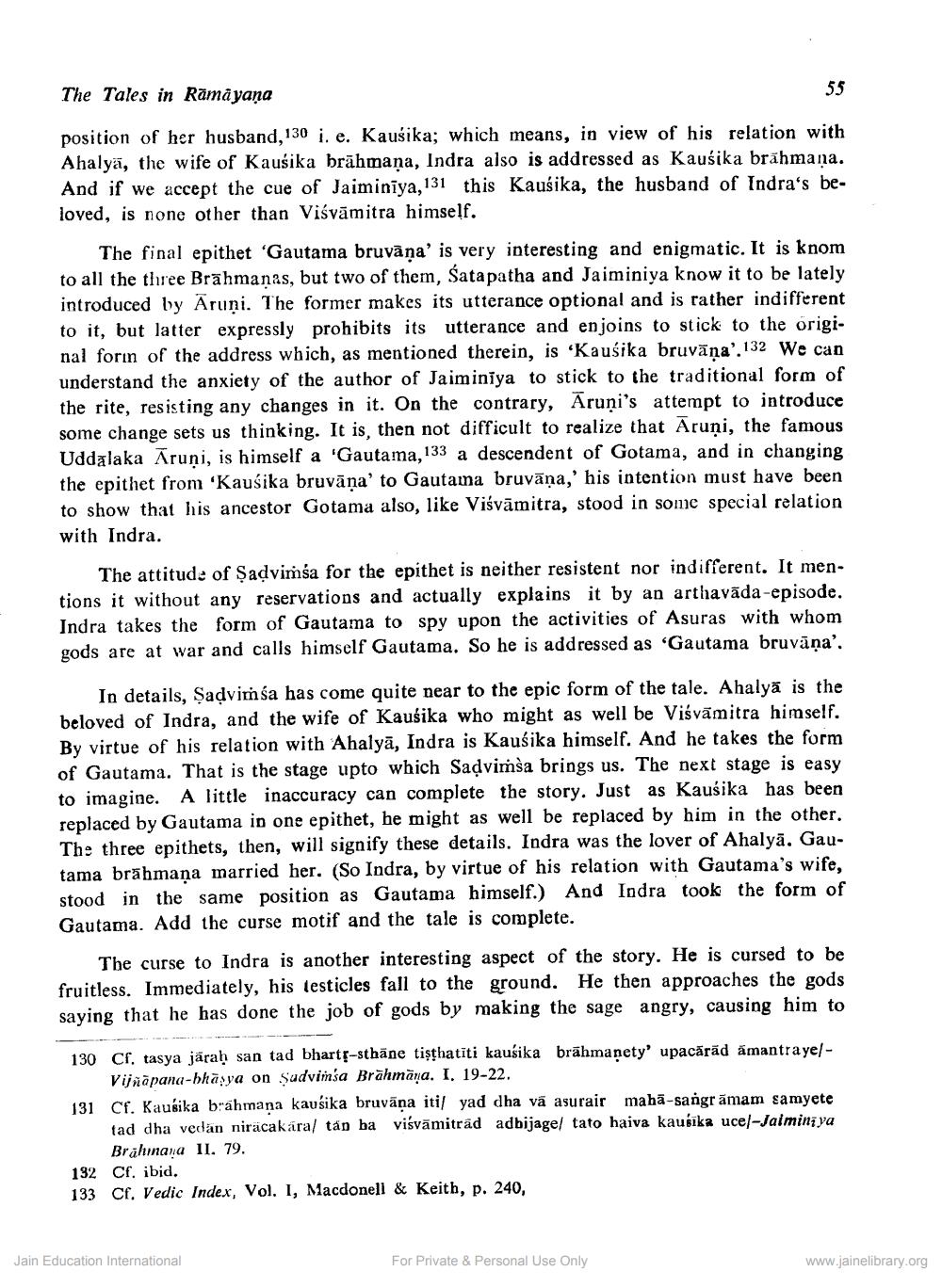________________
The Tales in Ramayana
55
position of her husband, 130 i. e. Kausika; which means, in view of his relation with Ahalyä, the wife of Kausika brāhmaṇa, Indra also is addressed as Kausika brāhmaṇa. And if we accept the cue of Jaiminīya,131 this Kausika, the husband of Indra's beloved, is none other than Viśvāmitra himself.
The final epithet 'Gautama bruvāna' is very interesting and enigmatic. It is knom to all the three Brāhmaṇas, but two of them, Śatapatha and Jaiminiya know it to be lately introduced by Aruņi. The former makes its utterance optional and is rather indifferent to it, but latter expressly prohibits its utterance and enjoins to stick to the original forın of the address which, as mentioned therein, is 'Kausika bruvāna'.132 We can understand the anxiety of the author of Jaiminiya to stick to the traditional form of the rite, resisting any changes in it. On the contrary, Aruņi's attempt to introduce some change sets us thinking. It is, then not difficult to realize that Aruņi, the famous Uddalaka Āruņi, is himself a 'Gautama, 133 a descendent of Gotama, and in changing the epithet from 'Kausika bruvāņa' to Gautama bruvāņa,' his intention must have been to show that his ancestor Gotama also, like Viśvāmitra, stood in some special relation with Indra.
The attitude of Şadvimśa for the epithet is neither resistent nor indifferent. It mentions it without any reservations and actually explains it by an arthavāda-episode. Indra takes the form of Gautama to spy upon the activities of Asuras with whom gods are at war and calls himself Gautama. So he is addressed as 'Gautama bruvāņa'.
In details, Sadvimśa has come quite near to the epic form of the tale. Ahalyă is the beloved of Indra, and the wife of Kausika who might as well be Viśvāmitra himself. By virtue of his relation with Ahalyā, Indra is Kausika himself. And he takes the form of Gautama. That is the stage upto which Sadvimša brings us. The next stage is easy to imagine. A little inaccuracy can complete the story. Just as Kausika has been replaced by Gautama in one epithet, he might as well be replaced by him in the other. The three epithets, then, will signify these details. Indra was the lover of Ahalyā. Gautama brāhmaṇa married her. (So Indra, by virtue of his relation with Gautama's wife, stood in the same position as Gautama himself.) And Indra took the form of Gautama. Add the curse motif and the tale is complete.
The curse to Indra is another interesting aspect of the story. He is cursed to be fruitless. Immediately, his testicles fall to the ground. He then approaches the gods saying that he has done the job of gods by making the sage angry, causing him to
130 cr. tasya järah san tad bharts-sthāne tişthatīti kausika brähmanety' upacāräd ämantra yel
Vijñāpana-bhāsya on Sudvimša Brāhmāna. I. 19-22. 131 Cf. Kausika brahmana kausika bruvāņa itil yad dha vă asurair mahā-sangrāmam samyete
tad dha vedan niracakára/ táp ha viśvāmitråd adbijagel tato haiva kausika ucel-Jaimini ya
Brahinana II. 79. 132 Cf. ibid. 133 Cf. Vedic Index, Vol. I, Macdonell & Keith, p. 240,
Jain Education International
For Private & Personal Use Only
www.jainelibrary.org




